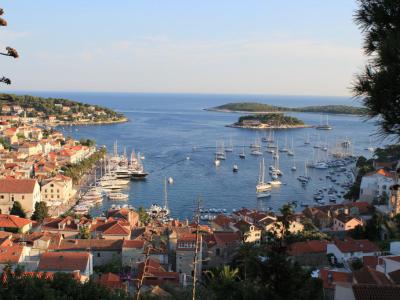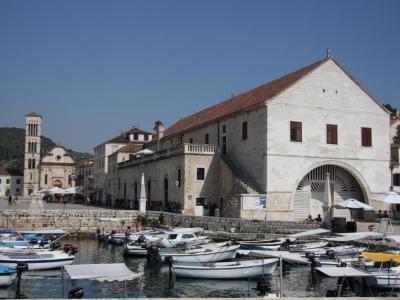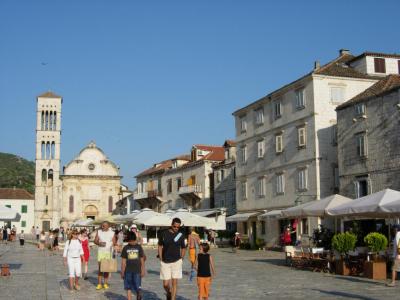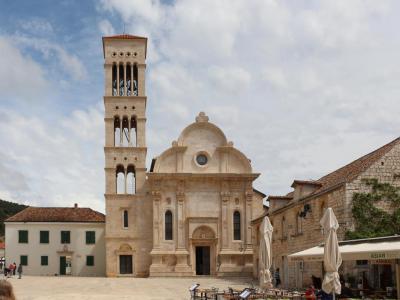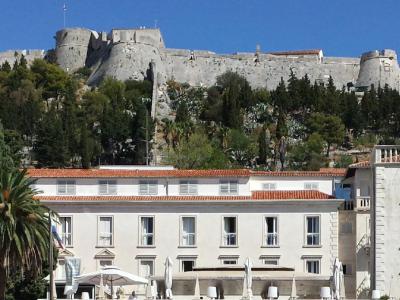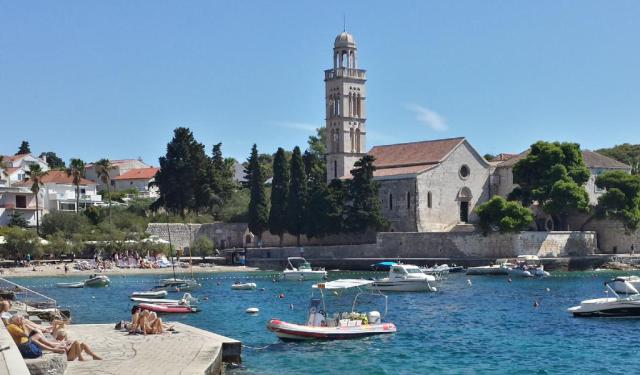
Hvar Introduction Walking Tour (Self Guided), Hvar
The biggest settlement on the Croatian island of the same name, Hvar is affectionately referred to as “Croatian Madeira”. The town boasts more than 2724 hours of sunshine per year, which is more than anywhere else in the country, plus a millennia-long history to boot.
Originally settled by Illyrians, it evolved from a small bay with a hill fort to a Greek colony, Pharos, in 384 BC. Romans followed in the 2nd century BC. From the 7th century onwards, the island was settled by the Pannonian Avars and Croats, who “slavicised” its name first as Quarra (because the Slavic languages at that time did not have the “f” sound) and then further to Hvar.
In the medieval era, Hvar sought Venetian protection in 1278, leading to its transformation into a fortified town named Lesina. The town walls, a new fortress, and coastal villages emerged during this time.
Challenges surfaced in the 16th century, with conflicts and Ottoman Empire attacks. By 1776, Hvar's significance waned as the Venetians relocated their naval base from the island. However, the 19th century, under Austrian Habsburg rule, brought economic and cultural revival, with the founding of "The Hygienic Association of Hvar" in 1868, marking the dawn of tourism.
Today, Hvar showcases its rich history through well-preserved architecture, including 700-year-old walls, noble houses, and buildings from the 15th to 17th centuries.
One of its most iconic features is the enchanting Hvar Harbour. Here, visitors can soak in the Mediterranean ambiance while admiring the Venetian Loggia and Clock Tower that gracefully overlook the harbor. Hvar Arsenal, built near the harbor in the 13th century, is another testament to the island's maritime heritage.
Saint Stephen's Square (Trg Svetog Stjepana) is the heart of Hvar's old town, a charming hub where locals and tourists gather to enjoy cafes, restaurants, and cultural events. Overlooking the square, the Hvar Cathedral, formally known as the Cathedral of Saint Stephen, is a magnificent religious site gracing the island with its Renaissance architecture.
For those seeking panoramic views and a dose of adventure, a visit to the Fortress Fortica is a must. Perched atop a hill, this 16th-century fortress offers breathtaking vistas of Hvar and the surrounding Adriatic Sea, making it a prime spot for sunset enthusiasts and history buffs alike.
With its wealth of historic locations and natural beauty, Hvar beckons visitors to embark on a journey of discovery. As you seek to reveal the secrets of this captivating island, prepare to be enchanted by the allure of Hvar and let its timeless appeal leave an indelible mark on your heart!
Originally settled by Illyrians, it evolved from a small bay with a hill fort to a Greek colony, Pharos, in 384 BC. Romans followed in the 2nd century BC. From the 7th century onwards, the island was settled by the Pannonian Avars and Croats, who “slavicised” its name first as Quarra (because the Slavic languages at that time did not have the “f” sound) and then further to Hvar.
In the medieval era, Hvar sought Venetian protection in 1278, leading to its transformation into a fortified town named Lesina. The town walls, a new fortress, and coastal villages emerged during this time.
Challenges surfaced in the 16th century, with conflicts and Ottoman Empire attacks. By 1776, Hvar's significance waned as the Venetians relocated their naval base from the island. However, the 19th century, under Austrian Habsburg rule, brought economic and cultural revival, with the founding of "The Hygienic Association of Hvar" in 1868, marking the dawn of tourism.
Today, Hvar showcases its rich history through well-preserved architecture, including 700-year-old walls, noble houses, and buildings from the 15th to 17th centuries.
One of its most iconic features is the enchanting Hvar Harbour. Here, visitors can soak in the Mediterranean ambiance while admiring the Venetian Loggia and Clock Tower that gracefully overlook the harbor. Hvar Arsenal, built near the harbor in the 13th century, is another testament to the island's maritime heritage.
Saint Stephen's Square (Trg Svetog Stjepana) is the heart of Hvar's old town, a charming hub where locals and tourists gather to enjoy cafes, restaurants, and cultural events. Overlooking the square, the Hvar Cathedral, formally known as the Cathedral of Saint Stephen, is a magnificent religious site gracing the island with its Renaissance architecture.
For those seeking panoramic views and a dose of adventure, a visit to the Fortress Fortica is a must. Perched atop a hill, this 16th-century fortress offers breathtaking vistas of Hvar and the surrounding Adriatic Sea, making it a prime spot for sunset enthusiasts and history buffs alike.
With its wealth of historic locations and natural beauty, Hvar beckons visitors to embark on a journey of discovery. As you seek to reveal the secrets of this captivating island, prepare to be enchanted by the allure of Hvar and let its timeless appeal leave an indelible mark on your heart!
How it works: Download the app "GPSmyCity: Walks in 1K+ Cities" from Apple App Store or Google Play Store to your mobile phone or tablet. The app turns your mobile device into a personal tour guide and its built-in GPS navigation functions guide you from one tour stop to next. The app works offline, so no data plan is needed when traveling abroad.
Hvar Introduction Walking Tour Map
Guide Name: Hvar Introduction Walking Tour
Guide Location: Croatia » Hvar (See other walking tours in Hvar)
Guide Type: Self-guided Walking Tour (Sightseeing)
# of Attractions: 6
Tour Duration: 1 Hour(s)
Travel Distance: 2.0 Km or 1.2 Miles
Author: nataly
Sight(s) Featured in This Guide:
Guide Location: Croatia » Hvar (See other walking tours in Hvar)
Guide Type: Self-guided Walking Tour (Sightseeing)
# of Attractions: 6
Tour Duration: 1 Hour(s)
Travel Distance: 2.0 Km or 1.2 Miles
Author: nataly
Sight(s) Featured in This Guide:
- Hvar Harbour
- Venetian Loggia and Clock Tower
- Hvar Arsenal
- Trg Sv Stjepana (St. Stephen's Square)
- Hvar Cathedral
- Fortress Fortica
1) Hvar Harbour
Hvar Harbour is a bustling maritime hub teeming with activity. The marina area may be relatively small, but it has a charming array of bars and shops that seamlessly transition into the narrow streets and alleys of the old town. Dining at a waterfront restaurant is a delightful experience, offering patrons a captivating view of the multitude of boats coming and going in the harbor.
The harbor's periphery is adorned with a variety of intriguing buildings and an abundance of dining establishments. There's ample space for leisurely strolls, making it the perfect place to take in the vibrant atmosphere.
Venturing into the labyrinthine alleyways and side streets reveals a maze of charming shops, market stalls, and local bars that connect to the harbor and extend to St. Stephen's Square and its magnificent cathedral. This pedestrian zone, with its broad square and surrounding streets, is an ideal destination for spending a half-day exploring. Here, you can peruse delightful souvenir and artisan shops, savor an ice cream, or enjoy a leisurely meal.
The energy in this area is vibrant and inviting, and the harbor itself is a sight to behold. With a diverse array of boats dotting the turquoise waters, it offers a picturesque view. The lovely promenade is lined with restaurants, bars, and coffee shops, making it a perfect location to soak in the coastal charm and the ever-enticing ambiance of Hvar Harbour.
The harbor's periphery is adorned with a variety of intriguing buildings and an abundance of dining establishments. There's ample space for leisurely strolls, making it the perfect place to take in the vibrant atmosphere.
Venturing into the labyrinthine alleyways and side streets reveals a maze of charming shops, market stalls, and local bars that connect to the harbor and extend to St. Stephen's Square and its magnificent cathedral. This pedestrian zone, with its broad square and surrounding streets, is an ideal destination for spending a half-day exploring. Here, you can peruse delightful souvenir and artisan shops, savor an ice cream, or enjoy a leisurely meal.
The energy in this area is vibrant and inviting, and the harbor itself is a sight to behold. With a diverse array of boats dotting the turquoise waters, it offers a picturesque view. The lovely promenade is lined with restaurants, bars, and coffee shops, making it a perfect location to soak in the coastal charm and the ever-enticing ambiance of Hvar Harbour.
2) Venetian Loggia and Clock Tower
Hvar's Venetian Loggia and Clock Tower stand as opulent examples of Renaissance architecture, with a rich history dating back several centuries. This remarkable structure was once a part of the Venetian governor's palace, a testament to the historical significance of the site.
The current design of the Loggia is from the High Renaissance, although records indicate the presence of a palace on this location as early as the 1300s. The original palace was much more extensive in its dimensions. Unfortunately, it suffered significant damage during an assault by the Ottoman forces in the late 1500s.
The clock tower, which is an integral part of this architectural ensemble, is a relatively later addition, having been constructed during the 1800s. It replaced an earlier clock tower that had been destroyed by the Turks centuries earlier.
Together, the Venetian Loggia and Clock Tower in Hvar represent a blend of historical, architectural, and cultural elements, providing visitors with a glimpse into the intricate layers of the town's past.
The current design of the Loggia is from the High Renaissance, although records indicate the presence of a palace on this location as early as the 1300s. The original palace was much more extensive in its dimensions. Unfortunately, it suffered significant damage during an assault by the Ottoman forces in the late 1500s.
The clock tower, which is an integral part of this architectural ensemble, is a relatively later addition, having been constructed during the 1800s. It replaced an earlier clock tower that had been destroyed by the Turks centuries earlier.
Together, the Venetian Loggia and Clock Tower in Hvar represent a blend of historical, architectural, and cultural elements, providing visitors with a glimpse into the intricate layers of the town's past.
3) Hvar Arsenal
The Hvar Arsenal is a historic building that carries a rich legacy. This architectural gem, originally constructed in the 14th century, had a utilitarian beginning as a maintenance shipyard for the galley of the commune. Over the centuries, it evolved and took on various roles, with its most notable addition being the historic theater, known as Hvarsko Kazalište, which was built in 1612 on the first floor, above the original galley space. Today, the Hvar Arsenal is a multi-functional building with the theater at its heart.
The history of the Hvar Arsenal reflects the dynamic changes in society and technology over the years. Its construction began between 1292 and 1331, a period marked by the decision to build and the confirmation of its existence. The location was carefully chosen to protect it from the unpredictable weather and rough seas that could affect Hvar's harbor, while also integrating it into the city's defensive fortifications. Notably, the city walls, which were later constructed, have never encompassed the Arsenal, along with several other significant buildings.
Throughout the 20th century, the ground floor of the Arsenal was primarily used as a warehouse. In the latter part of the century, it was even adapted to house a cinema. In more recent times, the versatile room has served as a venue for various performances and exhibitions.
The theater on the first floor, in the eastern part of the Arsenal, played a crucial role in the cultural life of Hvar for most of the 20th century. Unfortunately, due to safety concerns, it was closed in 1996. However, a renovation project, with a strong focus on fire safety, was initiated to preserve this historic space, ensuring that the Hvar Arsenal remains an essential cultural hub for the town and its visitors.
The history of the Hvar Arsenal reflects the dynamic changes in society and technology over the years. Its construction began between 1292 and 1331, a period marked by the decision to build and the confirmation of its existence. The location was carefully chosen to protect it from the unpredictable weather and rough seas that could affect Hvar's harbor, while also integrating it into the city's defensive fortifications. Notably, the city walls, which were later constructed, have never encompassed the Arsenal, along with several other significant buildings.
Throughout the 20th century, the ground floor of the Arsenal was primarily used as a warehouse. In the latter part of the century, it was even adapted to house a cinema. In more recent times, the versatile room has served as a venue for various performances and exhibitions.
The theater on the first floor, in the eastern part of the Arsenal, played a crucial role in the cultural life of Hvar for most of the 20th century. Unfortunately, due to safety concerns, it was closed in 1996. However, a renovation project, with a strong focus on fire safety, was initiated to preserve this historic space, ensuring that the Hvar Arsenal remains an essential cultural hub for the town and its visitors.
4) Trg Sv Stjepana (St. Stephen's Square)
Saint Stephen's Square is a remarkable rectangular square that extends from the harbor to the cathedral. This expansive square was created by filling in an inlet that once extended from the bay, making it one of the largest historic squares in Dalmatia, covering an area of 4,500 square meters. Hvar Town's fortified core, which dates back to the 13th century, is situated on the northern slopes of the square. However, the town's expansion to the south didn't occur until the 15th century.
One of the notable features in Saint Stephen's Square is a hidden well, nestled among the umbrellas of the restaurants closest to the cathedral. This historic well, constructed in 1520, is adorned with a wrought-iron grille dating back to 1780. St. Stephen's Square offers visitors a captivating blend of history, architecture, and a vibrant atmosphere, making it a must-visit location in Hvar.
One of the notable features in Saint Stephen's Square is a hidden well, nestled among the umbrellas of the restaurants closest to the cathedral. This historic well, constructed in 1520, is adorned with a wrought-iron grille dating back to 1780. St. Stephen's Square offers visitors a captivating blend of history, architecture, and a vibrant atmosphere, making it a must-visit location in Hvar.
5) Hvar Cathedral (must see)
The striking Roman Catholic Cathedral of Saint Stephen holds a place of prominence in the heart of Hvar, gracing the eastern side of the city square and marking the convergence of two distinct parts of the city. Its historical significance and architectural beauty make it a notable landmark in Hvar, attracting the attention of both residents and visitors alike.
The cathedral's origins harken back to a bygone era, with its foundation resting upon the sacred ground where an early 6th-century Christian church once stood. Additionally, a Benedictine convent dedicated to Saint Mary once shared this sacred space.
The current shrine, now known as the Cathedral of Saint Stephen, stands as a testament to the island's rich history and evolving architectural styles. The core of the cathedral is rooted in the remains of a Gothic church constructed during the 14th century. Remarkably, several remarkable historical artifacts have been preserved within its walls.
The interior of Saint Stephen's Cathedral boasts a 15th-century pulpit, adorned with intricate designs and artistic details. The stone polyptychs of Saint Luke and The Flagellation of Christ also grace the cathedral, providing visitors with an opportunity to immerse themselves in the artistic heritage of the region.
Adding to the cathedral's charm and historical appeal is the presence of a late Gothic crucifix, serving as a poignant symbol of faith and devotion that has withstood the test of time.
Architecturally, Saint Stephen's Cathedral is a splendid example of Dalmatian architecture, effortlessly blending the styles of the Renaissance, Mannerism, and early Baroque periods. Its triple-aisled structure harmoniously incorporates these diverse architectural elements, resulting in a visually captivating and historically significant place of worship.
The cathedral's 17th-century bell tower graces the skyline of Hvar, adding to its picturesque charm and providing a focal point for both locals and tourists to admire.
The cathedral's origins harken back to a bygone era, with its foundation resting upon the sacred ground where an early 6th-century Christian church once stood. Additionally, a Benedictine convent dedicated to Saint Mary once shared this sacred space.
The current shrine, now known as the Cathedral of Saint Stephen, stands as a testament to the island's rich history and evolving architectural styles. The core of the cathedral is rooted in the remains of a Gothic church constructed during the 14th century. Remarkably, several remarkable historical artifacts have been preserved within its walls.
The interior of Saint Stephen's Cathedral boasts a 15th-century pulpit, adorned with intricate designs and artistic details. The stone polyptychs of Saint Luke and The Flagellation of Christ also grace the cathedral, providing visitors with an opportunity to immerse themselves in the artistic heritage of the region.
Adding to the cathedral's charm and historical appeal is the presence of a late Gothic crucifix, serving as a poignant symbol of faith and devotion that has withstood the test of time.
Architecturally, Saint Stephen's Cathedral is a splendid example of Dalmatian architecture, effortlessly blending the styles of the Renaissance, Mannerism, and early Baroque periods. Its triple-aisled structure harmoniously incorporates these diverse architectural elements, resulting in a visually captivating and historically significant place of worship.
The cathedral's 17th-century bell tower graces the skyline of Hvar, adding to its picturesque charm and providing a focal point for both locals and tourists to admire.
6) Fortress Fortica (must see)
Hvar Fortress, commonly known as "Fortica" or "Spanish Fortress Hvar," is an iconic attraction in Hvar, Croatia, and an absolute must-visit. It stands as the most recognizable symbol of Hvar town. The fortress's origins can be traced back to the early 16th century, and it underwent significant renovations in 1579.
The foundations of Hvar Fortress rest upon ancient fortifications dating back to the first half of the first millennium BC. Byzantine forts were constructed in the 6th century, and the modern fortress's development began in 1282 during Venetian rule. Its construction was protracted, often supported by the proceeds from salt sales.
This fortress is a complex architectural marvel due to the irregular terrain it occupies. It comprised four towers, revelines, battlements, a loophole, a gunpowder building, one large and one smaller water tank, a crew room, a jail, and even a chapel. Together with the city walls, the fortress creates a formidable stronghold.
Construction began in 1278 when Hvar was under Venetian rule, although archaeological findings suggest that fortified structures may have existed there earlier. In 1551, a new fortress was erected on the site of the ancient fortification. Just two decades later, during the harrowing Turkish attack of 1571, local residents sought refuge and protection within its walls. However, in 1579, a thunderbolt struck the gunpowder depot, causing a devastating explosion and extensive damage. Restoration efforts did not commence until the early 17th century, under the rule of Prince Pietro Semitecolo. During this period, the Baroque bastions were added. In 1775-1776, during the reign of Maria Theresa, the Austrians constructed barracks within the fortress.
Today, Hvar Fortress houses a small museum featuring an impressive collection of amphoras, providing visitors with an opportunity to delve into the historical treasures of this remarkable site.
The foundations of Hvar Fortress rest upon ancient fortifications dating back to the first half of the first millennium BC. Byzantine forts were constructed in the 6th century, and the modern fortress's development began in 1282 during Venetian rule. Its construction was protracted, often supported by the proceeds from salt sales.
This fortress is a complex architectural marvel due to the irregular terrain it occupies. It comprised four towers, revelines, battlements, a loophole, a gunpowder building, one large and one smaller water tank, a crew room, a jail, and even a chapel. Together with the city walls, the fortress creates a formidable stronghold.
Construction began in 1278 when Hvar was under Venetian rule, although archaeological findings suggest that fortified structures may have existed there earlier. In 1551, a new fortress was erected on the site of the ancient fortification. Just two decades later, during the harrowing Turkish attack of 1571, local residents sought refuge and protection within its walls. However, in 1579, a thunderbolt struck the gunpowder depot, causing a devastating explosion and extensive damage. Restoration efforts did not commence until the early 17th century, under the rule of Prince Pietro Semitecolo. During this period, the Baroque bastions were added. In 1775-1776, during the reign of Maria Theresa, the Austrians constructed barracks within the fortress.
Today, Hvar Fortress houses a small museum featuring an impressive collection of amphoras, providing visitors with an opportunity to delve into the historical treasures of this remarkable site.
The Most Popular Cities
/ view all
